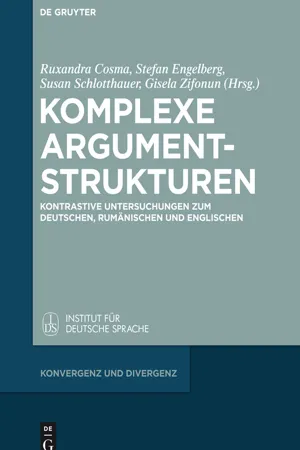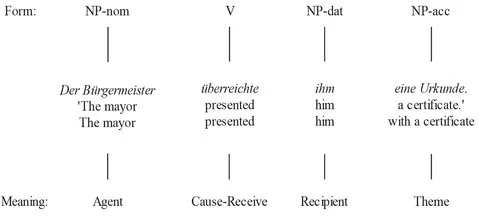Abstract
This contribution offers a fine-grained analysis of German and Romanian ditransitive and prepositional transfer constructions. The transfer construction (TC) is shown to be realised in German by 26 argument structure patterns (ASPs), which are conceived of as form-meaning pairings which differ only minimally. The mainstream constructionist view of the different types of TCs being related by polysemy links is rejected, the ASPs being argued instead to be related by family relationships. All but six of the ASPs identified for German are shown to possess a Romanian counterpart. For some ditransitive structures, German is shown to possess two prepositional variants, one with an (‘at’) and one with zu (‘to’) or auf (‘on’), while Romanian has only one. Due to the lack of a Romanian counterpart for the German zu and auf variants, Romanian lacks some of the dative alternations found in German. However, Romanian as well as German permits the double object pattern to interact with take-verbs, verbs of removal and add-verbs, which do not allow the ditransitive construction in English. Since these verb classes also permit at least one prepositional pattern in both languages, Romanian and German show a larger number of dative alternation types than English.
In diesem Beitrag werden deutsche und rumänische ditransitive und präpositionale Transfer-Konstruktionen feinkörnig analysiert. Es wird gezeigt, dass die Transfer-Konstruktion (TC) im Deutschen durch 26 Argumentstrukturmuster (ASPs: argument structure patterns), d.h. minimal unterschiedliche Form-Bedeutungspaare, realisiert ist. Die gängige konstruktionsgrammatische Auffassung, nach der die unterschiedlichen Typen von Transfer-Konstruktionen durch Polysemiebeziehungen miteinander verbunden sind, wird zugunsten eines Modells verworfen, das von Verwandtschaftsbeziehungen zwischen unterschiedlichen Transfer-Konstruktionen ausgeht. Alle bis auf sechs dieser ASP haben eine Entsprechung im Rumänischen. Während es im Deutschen in manchen Fällen zwei präpositionale Entsprechungen für eine einzige ditransitive Struktur gibt, nämlich eine mit an (‘at’) und eine mit zu (‘to’) oder auf (‘on’), weist das Rumänische jeweils nur eine präpositionale Variante für eine ditransitive Struktur auf. Demzufolge fehlen im Rumänischen manche Typen der Dativalternationen, die im Deutschen möglich sind. Das Doppel-Objekt-Muster tritt aber sowohl im Deutschen als auch im Rumänischen mit nehmen-Verben, entfernen-Verben und hinzufügen-Verben auf, die im Englischen nicht mit der Ditransitiv-Konstruktion vorkommen. Da diese Verben in beiden Sprachen auch mit mindestens einem präpositionalen Muster vorkommen können, weisen sowohl das Rumänische als auch das Deutsche insgesamt eine größere Anzahl an unterschiedlichen Typen von Dativalternationen auf.
1. Introduction: Transfer constructions vs. benefactive constructions
A transfer construction (TC) is a construction which pairs a transfer meaning either with a ditransitive pattern, i.e. a pattern consisting of a verb, a subject-NP and two object-NPs, or with a pattern consisting of a verb, a subject-NP, an object-NP and a PP. Transfer here is understood to cover cases where an entity is caused to go from one location to another, where a location may be either a physical entity such as the place where the transferred entity originates from or is caused to go to or an animate entity such as an Agent or a Recipient. Ditransitive transfer constructions have been dealt with extensively from a variety of different perspectives, both theoretical and empirical, with respect to English (cf. Green 1974; Oehrle 1976; Allerton 1978; Erteschik-Shir 1979; Larson 1988; Levin 1993; Goldberg 1995; Rappaport Hovav/Levin 2008 among others). Ditransitive constructions have been studied considerably less frequently for German. They are usually listed as one of the valency patterns co-occurring with a relatively small number of verb classes in German reference grammars (cf. Paul 1959; Grundzüge 1980; Zifonun/Hoffmann/Strecker 1997; Duden 2006). The whole variety of verbs co-occurring with the ditransitive pattern is covered only in Wegener’s study of the dative in German (cf. Wegener 1985).
In the present contribution, ditransitive and prepositional realisations of the TC in German are studied from a constructionist perspective. The TC is shown to be realised by a variety of different ditransitive and prepositional micro-constructions called “argument structure patterns” (ASPs). These are conceived of as form-meaning pairings which differ only minimally. German micro-constructions will be searched for empirically, using lists of argument realisations of German verbs, valency dictionaries and corpora. Each micro-construction will be studied with respect to the variety of verb classes it co-occurs with, its semantic roles and with respect to the constraints on the range of nominal expressions realising these. The TC is here represented as a family of a large number of different constructions. Previous constructionist approaches have not described the same phenomena in such a fine-grained fashion, representing the TC instead as a single polysemous construction. The analysis chosen allows minimal differences between argument structure patterns to be captured not only within a single language, but also cross-linguistically. Micro-constructions found in German will be used as the basis for a search of corresponding constructions in Romanian. A cross-linguistic comparison of micro-constructions is promising, because claims about the distribution of the TC and the constraints associated with it have so far been formulated only with respect to English (cf. Green 1974; Oehrle 1976; Goldberg 1992, 1995).
A German example of the TC is Der Bügermeister überreichte ihm eine Urkunde (‘The mayor presented him with a certificate’). In this example, the form [NP-nominative V NP-dative NP-accusative] is paired with the meaning ‘Agent causes Recipient to receive Theme’, where the NP in the nominative case realises the role of the Agent, the dative NP expresses the role of the Recipient and the NP in the accusative case encodes the role of the Theme, as illustrated below:
Fig. 1: Transfer construction: Form and semantic roles
Other examples of the TC in German include:
Transfer constructions like those in (1) – (3) are a subclass of the class of double object or ditransitive structures. The latter also comprises benefactive constructions, which may also have the form [NP-nom V NP-dat NP-acc] but pair it with the meaning ‘Agent carries out action involving Patient/Theme for the benefit of a Beneficiary’ (as in Sally bought John a book). Apart from being realised by a double object pattern, benefactive constructions may also be expressed by a prepositional variant of these (e.g., Sally bought a book for John) as may transfer constructions (see below). In some cases, ditransitive TCs may not easily be distinguished from ditransitive benefactive constructions. This is due to the fact that Recipients may not always easily be distinguished from Beneficiaries. Some Recipients ...



